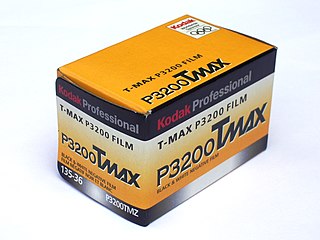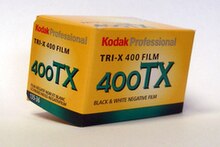
Film stock is an analog medium that is used for recording motion pictures or animation. It is recorded on by a movie camera, developed, edited, and projected onto a screen using a movie projector. It is a strip or sheet of transparent plastic film base coated on one side with a gelatin emulsion containing microscopically small light-sensitive silver halide crystals. The sizes and other characteristics of the crystals determine the sensitivity, contrast and resolution of the film. The emulsion will gradually darken if left exposed to light, but the process is too slow and incomplete to be of any practical use. Instead, a very short exposure to the image formed by a camera lens is used to produce only a very slight chemical change, proportional to the amount of light absorbed by each crystal. This creates an invisible latent image in the emulsion, which can be chemically developed into a visible photograph. In addition to visible light, all films are sensitive to X-rays and high-energy particles. Most are at least slightly sensitive to invisible ultraviolet (UV) light. Some special-purpose films are sensitive into the infrared (IR) region of the spectrum.

Film speed is the measure of a photographic film's sensitivity to light, determined by sensitometry and measured on various numerical scales, the most recent being the ISO system. A closely related ISO system is used to describe the relationship between exposure and output image lightness in digital cameras.

Kodachrome is the brand name for a color reversal film introduced by Eastman Kodak in 1935. It was one of the first successful color materials and was used for both cinematography and still photography. For many years Kodachrome was widely used for professional color photography, especially for images intended for publication in print media. Because of its complex processing requirements, the film was sold process-paid in the United States until 1954, when a legal ruling prohibited that. However, the arrangement continued in other markets.

In photography, reversal film or slide film is a type of photographic film that produces a positive image on a transparent base. Instead of negatives and prints, reversal film is processed to produce transparencies or diapositives. Reversal film is produced in various sizes, from 35 mm to roll film to 8×10 inch sheet film.

Velvia is a brand of daylight-balanced color reversal film produced by the Japanese company Fujifilm. The name is a portmanteau of "Velvet Media", a reference to its smooth image structure. The original incarnation of the film was called "Velvia for Professionals", known as RVP, a classification code meaning "Reversal/Velvia/Professional series". It is known for its extremely high level of color saturation and image quality.

Push processing in photography, sometimes called uprating, refers to a film developing technique that increases the effective sensitivity of the film being processed. Push processing involves developing the film for more time, possibly in combination with a higher temperature, than the manufacturer's recommendations. This technique results in effective overdevelopment of the film, compensating for underexposure in the camera.

Instant film is a type of photographic film that was introduced by Polaroid Corporation to produce a visible image within minutes or seconds of the photograph's exposure. The film contains the chemicals needed for developing and fixing the photograph, and the camera exposes and initiates the developing process after a photo has been taken.

Ektachrome is a brand name owned by Kodak for a range of transparency, still, and motion picture films previously available in many formats, including 35 mm and sheet sizes to 11 × 14 inch size. Ektachrome has a distinctive look that became familiar to many readers of National Geographic, which used it extensively for color photographs for decades in settings where Kodachrome was too slow. In terms of reciprocity characteristics Ektachrome is stable at shutter speeds between ten seconds and 1/10,000 of a second.

Svema is a registered trade mark and former name of the Shostka Chemical Plant, located in Shostka, Sumy Oblast, Ukraine. It was founded in 1931 in then Ukrainian SSR.

FILM Ferrania s.r.l. is a modern photographic film manufacturing company located in Ferrania (Liguria), Italy. FILM Ferrania had been founded in 1923 as a maker of photographic film, papers, and photographic equipment, including cameras. The company was purchased in 1964 by the 3M company to become Ferrania 3M, until it was spun off in 1996 to 3M's Imation division. In 1999, Ferrania was acquired by Schroder Ventures and then spun off as a separate company. Subsequently, it was acquired by a Genoese shipping company, Gruppo Messina who ceased photographic activities in 2009.

Provia is a brandname for a pair of daylight-balanced color reversal films produced by the Japanese film company Fujifilm. It is currently available in one speed, 100/21°, marketed as Fujichrome Provia 100F Professional [RDP III],. An additional speed of 400/27°, marketed as Fujichrome Provia 400X Professional [RXP], was previously available.

Analog photography, also known as film photography, is a catch-all term for photography that uses chemical processes to capture an image, typically on paper, film or a hard plate. These analog processes were the only methods available to photographers for more than a century prior to the invention of digital photography, which uses electronic sensors to record images to digital media.

Ilford Delta is a series of photographic films manufactured by Harman Technology Limited. Delta films are tabular-grain black-and-white films, and originally released in 400 ISO only to compete with Kodak's T-Max film.

Kodak Professional T-MAX Film is a continuous tone, panchromatic, tabular-grain black and white negative film originally developed and manufactured by Eastman Kodak since 1986. It is still manufactured by Eastman Kodak but distributed and marketed by Kodak Alaris, as with other products under Kodak Professional banner.

Photographic film is a strip or sheet of transparent film base coated on one side with a gelatin emulsion containing microscopically small light-sensitive silver halide crystals. The sizes and other characteristics of the crystals determine the sensitivity, contrast, and resolution of the film.

Foma Bohemia spol. s.r.o is a photographic company based in Hradec Králové, Czech Republic established in 1921, originally as Fotochema, being renamed in 1995 on privatisation. They are mostly known for their line of black and white films and papers but also produce movie film, X-ray films for medicine and industry and personal dosimetry film along with processing chemicals. They formerly produced aerial and surveillance films.




















